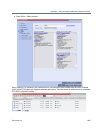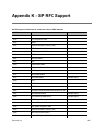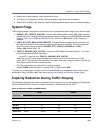
Polycom, Inc. 1067
Appendix L - Media Traffic Shaping
Polycom integrated traffic shaping capabilities into the RealPresene Collaboration Server to enable
deploying Collaboration Server systems in networks limiting packet bursts within 100ms time intervals (or
more). Setting router policies to limiting of bandwidth within a time interval, causes the router to drop packets
exceeding the allowed bandwidth within this interval. Therefore, using this feature enables the MCU to
flatten the traffic, and minimize traffic bursts, without exceeding the bandwidth allowed within the time
interval.
Though the
Collaboration Server supports high level network features, high quality of service requires
end-to-end video network operation. The
Collaboration Server traffic shaping capabilities cannot compensate
for network level violations/limitations generated by elements outside the MCU, such as endpoints, routers,
etc.
Traffic shaping can flatten a momentary burst (meaning, within a 100ms time interval). However, it cannot
“flatten” longer bursts resulting from endpoints sharing content in video switching conferences. Similarly, this
feature helps reducing packets dropping by routers following momentary traffic bursts, yet it does not
resolve packet lost by faulty network connections or network congestion.
Note that during VSW content sessions, should source endpoint exceed the negotiated content rate for over
100ms, the
Collaboration Server can flatten the video channel but not the incoming content channel.
Traffic Shaping Guidelines
● Traffic shaping is applied in the following conferencing modes and scenarios:
AVC conferences (both CP and VSW)
Mixed CP and SVC conferences - applied only on AVC endpoints
Content VSW
This feature is not applied on TIP endpoints.
● Capacity of CIF/SD resolutions on MPMx cards is reduced when traffic shaping is on: CIF capacity is
reduced from 90 to 70 (20% reduction), and SD capacity is reduced from 60 to 50, in terms of ports.
Capacity of mixed AVC/SVC calls is also reduced when traffic shaping is enabled.
Capacities of 720p and up are unaffected.
● License entitlement ratio for SD and CIF is reduced from 1:2 to 1:1.5 on Collaboration Servers with
MPMRx media card(s); license entitlement ratio for SD is reduced from 1:2 to 5:3, and for CIF - from
1:2 to 7:3 on Collaboration Servers with MPMx media card(s).
● Traffic shaping code is embedded in the DSP ART modules thus requiring enlarging PCI memory size
to 18Mbps, and content memory size to that of video.
● In MPMx MCUs, if all DSP units are defined as ART, each MPMx-D card can allocate 360 audio-only
ports. Yet, if all DSP units are set to full video (meaning, no voice), a CIF port is allocated for audio
only, resulting in audio capacity reduction similar to that of CIF capacity reduction (see Capacity
Reduction in MPMx and MPMRx MCUs).
● Should license port capacity be lower than the number of hardware ports, the unlicensed ports are
used for traffic shaping to decrease capacity reduction.
● Traffic shaping is applied on the aggregation of both content and people channels.


















